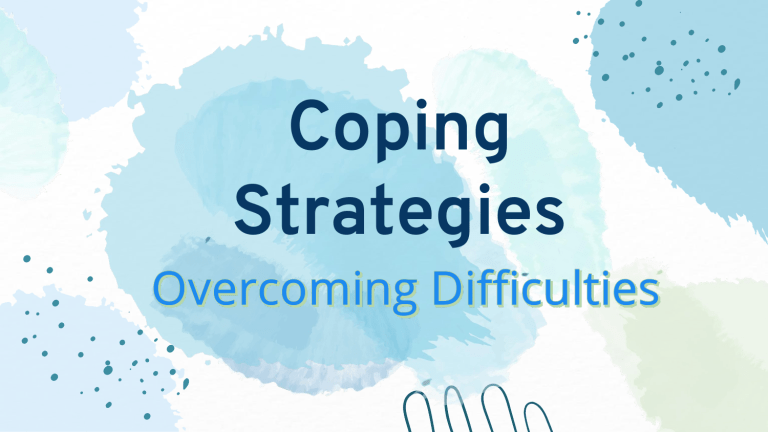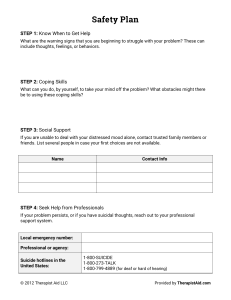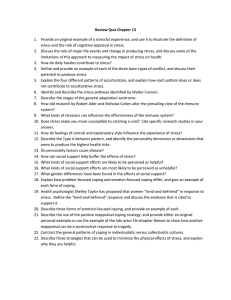
Coping Strategies Coping (Psychology) In psychology, coping is expending conscious effort to solve personal and interpersonal problems, and seeking to master, minimize or tolerate stress or conflict. Psychological coping mechanisms are commonly termed coping strategies or coping skills. Mental Health Issues (DOH, Resource Mapping 2017-2020) 3.6 million Filipinos are battling mental health issues as the 1.14 Philippines million continues to grapple with the COVID-19 pandemic 520,000 were are battling Filipinos have 847,000 alcohol-use depression disorders Schizophrenia diagnosed with 213,422 bipolar disorder 5,570 Suicide deaths per year TYPES OF COPING STRATEGIES Emotion-focused Coping Emotion-focused coping is a type of stress management that attempts to reduce negative emotional responses associated with stress. Negative emotions such as embarrassment, fear, anxiety, depression, excitement and frustration are reduced or removed by the individual by various methods of coping. Emotion-focused techniques might be the only realistic option when the source of stress is outside the person’s control. Distraction, e.g. keeping yourself busy to take your mind off the issue. Emotional disclosure. This involves expressing strong emotions by talking or writing about negative events which precipitated those emotions (Pennebaker, 1995) Drug therapy can be seen as emotion focused coping as it focuses on the arousal caused by stress not the problem. Praying for guidance and strength Meditation, e.g. mindfulness. Eating more, e.g. comfort food. Drinking alcohol. Journaling, e.g. writing a gratitude diary (Cheng, Tsui, & Lam, 2015). What is the focus of this coping mechanism? The focus of this coping mechanism is to change the meaning of the stressor or transfer attention away from it. Emotion-focused coping is well suited for stressors that seem uncontrollable (ex. a terminal illness diagnosis, or the loss of a loved one). Some mechanisms of emotion focused coping, such as distancing or avoidance, can have alleviating outcomes for a short period of time, however they can be detrimental when used over an extended period. Positive emotion focused mechanisms, such as seeking social support, and positive re-appraisal, are associated with beneficial outcomes Types of coping strategies 2. problem-focused: Directed towards reducing or eliminating a stressor, adaptive behavioral People using problem-focused strategies try to deal with the cause of their problem. They do this by finding out information on the problem and learning new skills to manage the problem. Problem-focused coping is aimed at changing or eliminating the source of the stress. The three problem-focused coping strategies identified by Folkman and Lazarus are taking control, information seeking, and evaluating the pros and cons Which type is more useful? Emotional-focused coping Problem-focused coping All these methods can prove useful, but some claim that those using problemfocused coping strategies will adjust better to life. Problem-focused versus emotion-focused Problem-focused coping mechanisms may allow an individual greater perceived control over their problem, whereas emotion-focused coping may sometimes lead to a reduction in perceived control (maladaptive coping). Positive techniques (adaptive or constructive coping) proactive coping. Anticipation is when one reduces the stress of some difficult challenge by anticipating what it will be like and preparing for how one is going to cope with it social coping, such as seeking meaning-focused concentrates experience. on coping, deriving social support in which meaning from Yet another way of coping circumstances that cause stress. is avoiding from the the others person stressful thoughts Adequate nutrition, exercise, sleep contribute management, as do physical fitness and techniques such as progressive muscle relaxation. or to stress relaxation Negative techniques (maladaptive coping or noncoping) Dissociation is the ability of the mind to separate and compartmentalize thoughts, memories, and emotions. This is often associated with post traumatic stress syndrome. Sensitization is when a person seeks to learn about, rehearse, and/or anticipate fearful events in a protective effort to prevent these events from occurring in the first place. Safety behaviors are demonstrated when individuals with anxiety disorders come to rely on something, or someone, as a means of coping with their excessive anxiety. Anxious avoidance is when a person avoids anxiety provoking situations by all means. This is the most common strategy. Escape is closely related to avoidance. This technique is often demonstrated by people who experience panic attacks or have phobias. These people want to flee the situation at the first sign of anxiety. What is one of the most positive methods? humor While dealing with stress it is important to deal with your physical, mental, and social well being. Physically, one should maintain one's health and learn to relax if one finds oneself under stress. Mentally it is important to think positive thoughts, value oneself, demonstrate good time management, plan and think ahead, and express emotions. Socially one should communicate with people and seek new activities. By following these simple strategies, one will have an easier time responding to stresses in one's life SELF-REFLECTION is to gain self-awareness through the self-realizations that occur within when we sit with ourselves, delving deeper into our conscious & subconscious mind. Reflecting upon the past… See deeper within With clarity Which leads us to… acknowledging accepting understanding forgiving Being honest with yourself is said to be one of the hardest to do Make excuses Blame others Hold on to what we should let go Acceptance Inner peace Self-reflection Self-controlled mindset When we resist, tension grows When we don’t do what is our best interest, depression always follows To evolve To grow To flourish We cannot begin to change the world around us until, we begin to change the world within us. THANKS! CREDITS: This presentation template was created by Slidesgo, including icons by Flaticon, infographics & images by Freepik


